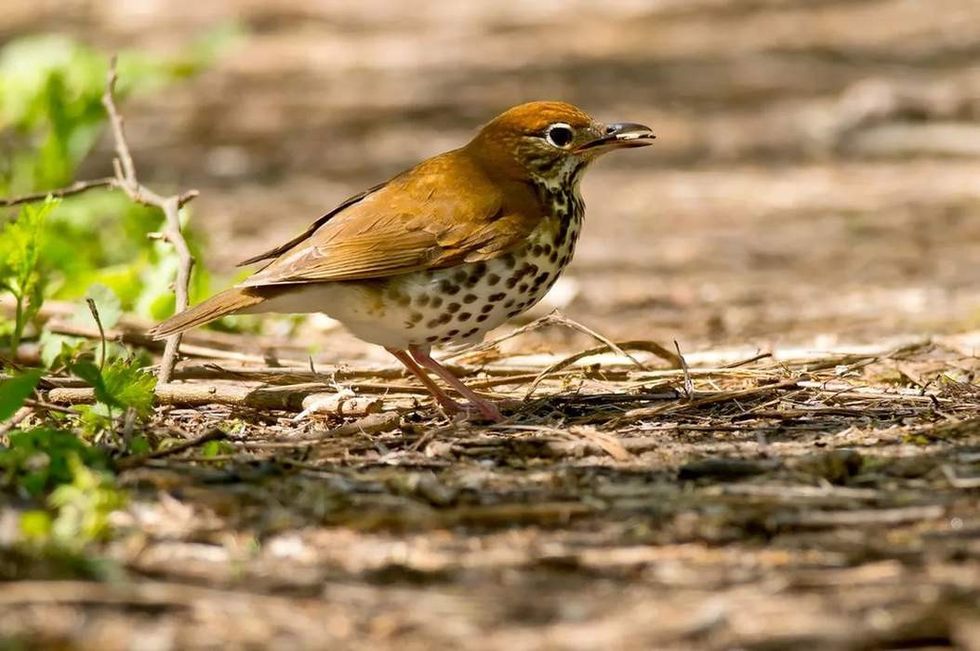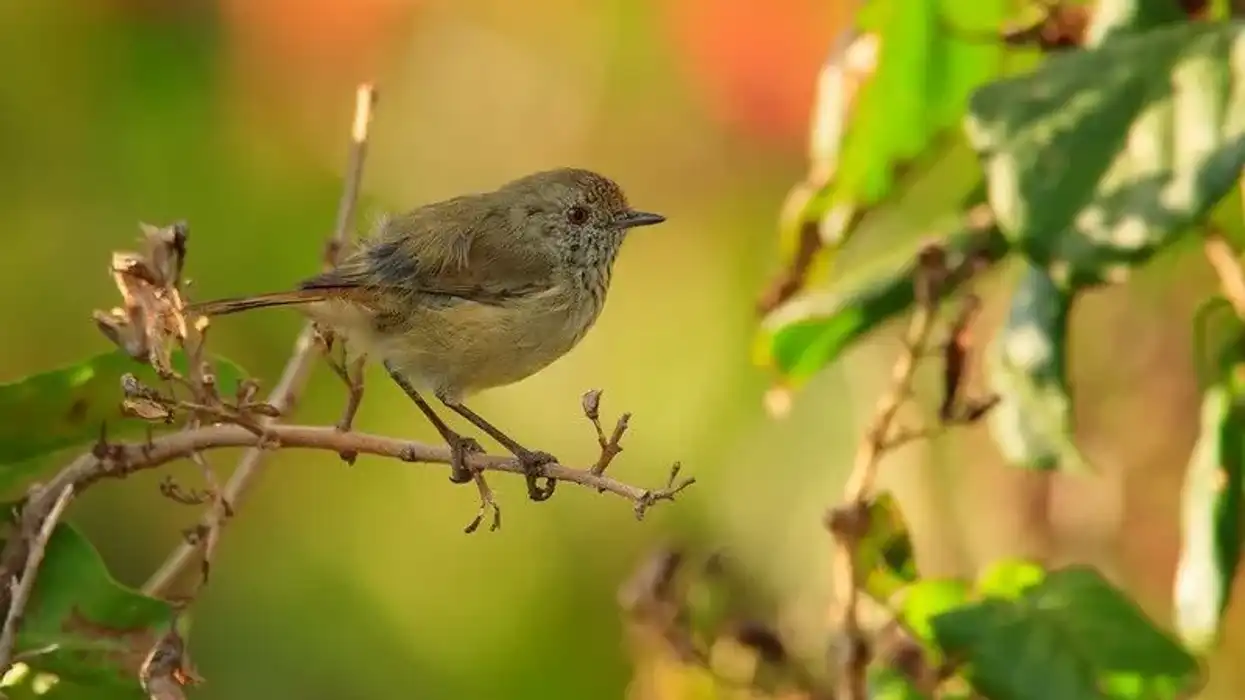The Wood Thrush is a type of passerine bird found in North America. They are famous for their wonderful songs and the sounds they make such as 'ee oh lay'.
It is the official bird of the district of Columbia, but lately the bird's population is at risk of steadily declining. This fall in population is primarily due to the destruction of their natural wild habitat in the forests.
Cowbird parasitism also leads lower chances of reproductive success for these birds. In addition to that, these birds also have a large list of predators ranging from raccoons, chipmunks, crows, domestic cats, and squirrels.
As of yet, there have not been many bird conservation efforts for this bird but scientists may feel the need to introduce bird conservation programs for this species sooner than anticipated. Keep reading the article to find out more interesting facts about Wood Thrushes.
If you like this article, then check out other articles with amazing facts about the anhinga and house finch as well.
Wood Thrush Interesting Facts
What type of animal is a Wood Thrush?
A Wood Thrush (Hylocichla Mustelina) is a type of a bird.
What class of animal does a Wood Thrush belong to?
A Wood Thrush belongs to the Aves class of animals and its genus is Hylocichla. It belongs to the family of Turdidae, while its phylum is Chordata.
How many Wood Thrushes are there in the world?
The International Union for Conservation of Nature has estimated that there are approximately 12,000,000 wood thrushes in the world. However, they have also noted that the population trend of this bird is decreasing.
Where does a Wood Thrush live?
A Wood Thrush bird is primarily found in the continent of North America. It is seen between the geographical range of Southern Canada and the southern part of the United States of America.
They are found near the Missouri River and the eastern part of the Great Plains. They prefer to spend their winters in warmer places like Mexico and Central America.
What is a Wood Thrush's habitat?
The Wood Thrush bird's primary habitat is deciduous and mixed forests but not tropical forests. The ideal habitat or breeding ground for them would consist of an open forest with moist soil, tall tree, or shrub which is quite dense along with leaf litter on the forest floor.
They usually prefer a habitat with a temperate climate but move to tropical climates during winter.
Who do Wood Thrushes live with?
Wood Thrushes are mostly solitary animals as they prefer to live alone. However, they have also been seen to create flocks with other species of birds as well.
These birds are also quite territorial and get defensive about their own territory which might also be their nest site. They use their territory in the forests for the gathering of food or nest materials. They also protect their feeding territory in the winter season.
How long does a Wood Thrush live?
The average lifespan of a Wood Thrush is between 8-9 years in the wild.
How do they reproduce?
Wood Thrushes are monogamous birds and mating pairs form once during a breeding season. However, these birds will change their mating partners each year. Female Wood Thrushes lay their eggs in the late summer months although the breeding process starts from mid-April to early May.
The breeding process of this species of North American birds is quite fascinating. Male Wood Thrushes choose suitable breeding grounds and carve out their territory.
Then, the female birds fly in circular motions with the males chasing after them. Between these flights, the pair sits together on a tree and feeds each other as well. The male Wood Thrush keeps singing melodious tunes throughout the season from dawn to dusk.
During the later part of the breeding season, their songs become more intense and for shorter amounts of time. Then, the female bird chooses an appropriate nest site to lay the eggs.
The mating pairs attempt to create two broods of chicks and the female Wood Thrush lays around 2-4 eggs per day in each individual nest. They incubate the eggs for 11-14 days and they brood the newborn chicks for four days after hatching.
Both female and male Wood Thrush parents feed and look after the young and also remove excreta from the nest. The parents feed the young until it matures fully and becomes independent enough to leave 21-31 days after birth.
What is their conservation status?
This bird is in the Least Concern category under the Red List of the International Union for Conservation of Nature (IUCN). Although it is currently in the Least Concern category, the overall population of the bird is declining which is leading researchers to believe that they might soon enter the Near Threatened category.
Wood Thrush Fun Facts
What do Wood Thrushes look like?

Female and male birds of this species look the same in terms of size and feathers. Younger birds have more spots on their backs and necks. Wood Thrushes are also quite similar looking to other thrush birds but can be differentiated by their rust-colored head and white chest.
Wood Thrushes have a warm cinnamon brown colored crown and nape, with a more muted shade of brown on their back, neck, and back wings and tail. They have a white-colored chest with large brown spots on their sides and breasts. Their bill is of a dark brown color.
How cute are they?
These small birds might not be very colorful or attractive to look at, but they are quite cute nonetheless! If you love a bird that has a wonderful singing capability, you will find the Wood Thrush very cute.
How do they communicate?
Wood Thrushes primarily use sound and body language to express themselves. The songs of the male bird become particularly significant during the mating season. The female birds have not been observed to sing. When they feel threatened or agitated, these birds may also use some unique sounds such as "bop bop" or "tut-tut" to signal their distress.
How big is a Wood Thrush?
Wood Thrushes are not very big birds and their average length lies between the range of 7.4-8.2 in (19-21 cm). Their wingspan is usually the length of 12-16 in (30-40 cm). The Aldabra Tortoise is around five times the size of a Wood Thrush bird.
How fast can a Wood Thrush fly?
While the Wood Thrush (Hylocichla Mustelina) may not be the fastest flying bird, they are very tenacious flyers. They can easily cover long distances during migration at a steady, quick speed. They can fly for almost a hundred miles without break at night and then gain back their energy during the day.
How much does a Wood Thrush weigh?
The weight of a Wood Thrush bird lies between 0.08-0.1 lb (40-50 g).
What are their male and female names of the species?
There are no separate or unique names for the male and female type of this species so they are denoted as male or female Wood Thrush birds.
What would you call a baby Wood Thrush?
A baby Wood Thrush does not have a separate name and they are called nestlings when they slowly start to develop from eggs.
What do they eat?
The Wood Thrush bird is omnivorous in nature, although it prefers to feed on invertebrates and larvae. They also eat insects, small salamanders and snails.
After breeding is completed and before they start migration, these birds start consuming fruits with a high fat level during late summer, autumn and winter months. These birds mostly go through leaf litter on the forest floor looking for insects wandering around in the soil.
They poke through the leaf litter with their bills searching for food but can swallow whole fruits.
Are they dangerous?
Wood Thrushes are not dangerous to humans but do hunt down invertebrates and larvae in the forests for food.
Would they make a good pet?
Wood Thrushes would not make a very good pet since these are primarily North American birds who prefer to build their nest in the wild in forests. These brown-headed birds prefer to create their nest, create two broods and lay eggs on the forest floor.
Therefore, they would not be able to adapt to the domestic environment in suburban or rural homes.
Did you know...
Wood Thrushes are mostly non-violent birds and do not engage in physical altercations. Therefore, they settle conflicts about territory without any physical contact. However, during intense situations, these birds have been seen to fight with their feet or bills.
These brown-headed birds also display "anting" behavior which is quite peculiar. In this process, a bird picks up an ant or many ants and starts to rub them on its feathers.
Scientists have not yet been able to figure out the reason behind this strange behavior but hypothesize that the birds might use the secretions from ant as a sort of medicine.
The Wood Thrush's call
The Wood Thrush song is probably the most melodious bird song heard in the forest of North America. The Wood Thrush call or Wood Thrush sound is quite unique as well.
Male Wood Thrushes sing unique songs during the mating season that have a trill-like quality. Their song has a flute-like quality since they can sing two notes simultaneously. Their flute like voice can be heard throughout the summer months in forests.
They also have unique calls to communicate with each other during times of distress. Their sounds may also resemble an 'ee oh lay' vocal pattern.
The Wood Thrush's nests
The creation of a proper nest for these birds becomes very important specifically during their mating season. Before laying eggs, the female bird chooses an appropriate nest site made of leaves, dead grass, and twigs where she will try to deliver her eggs.
The males sometimes can influence where the nest will be made through their singing but they often do not have much of a say on where the breeding nest will be created.
The nest is usually built on a tree or shrub in the forest. These birds also have to protect their nest from nest predators and parasites in the forest.
Here at Kidadl, we have carefully created lots of interesting family-friendly animal facts for everyone to discover! Learn more about some other birds including secretary bird, or western tanager.
You can even occupy yourself at home by drawing one on our Wood Thrush coloring pages.










